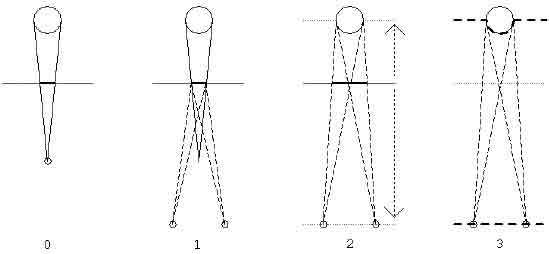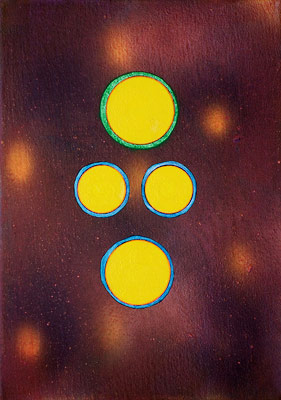Surface of Things
sitemap
drawings
paintings 1 2 3 4 5 5 a b c -
- A B . . . . . . . new
installations
projects
reviews
Giuseppe Galli (1887-1953) |
Giuseppe Galli (1887-1953) |
Surface of Things
Lorens Holm
On Being Duchamp and Maybe Alberti, Even*
When I was a kid, I spent hours looking out the living room window of my parents’ fourth floor apartment in New York, apt 41, 418 West 118 Street (it no longer exists, I can still draw the plan). Window open, me kneeling, elbows on the large sill with a wrought iron window guard, all black painted arabesques, holding in dusty flower pots (that’s what a Manhattan garden is), staring across the street at the windows of the buildings opposite (the street grid of NY re(pro)duced in the grid of windows). It’s a classic Edward Hopper scene, looking out, looking in a window, except my story pursues a different optic.
If I looked at the windows across the street, our window guard doubled; and if I looked at the window guard, the windows doubled. This sunlit city, when distanced, doubled; without univocal register in the world; and me inside this cool shadowy living room staring out. And when I tried very hard, by various experiments to get to the bottom of this problem, the problems only intensified. When I closed my right eye, things seemed to register properly in both places; finally I had got it right, at least it was clear which image was real and which its flame-like double. But when I checked my results by using the other eye, I got a conflicting picture with as much claim on reality. Cut. Jump. Flutter. And: depending upon where I focused, it seemed that either the window guard jumped or the building jumped. Did the person in the window opposite have the same problem with me?

Fig. 0. Alberti's window: the cyclopean picture of an object. A single eye aligns with the point of projection, effacing the difference between viewing the object and viewing the image of the object.
Fig. 1. Viewing Alberti's window with two eyes: the eyes meet at the picture surface.
Fig. 2. Viewing through Alberti's window. The perspective model for viewing an object with two eyes always leads to a double image. Alberti's window begins to disappear and the veil (a two-sided surface), begins to bifurcate…
Fig. 3. …to become two single-sided surfaces wrapping the object and the soul. Hence: viewing an object in a state of distraction, unencumbered by any conceptual apparatus.
I did not know what was wrong; I lacked even the terms with which to explain it. Why is it that the interior of my parents living room seems perfectly stable, but whenever I try to frame the outside from the inside, the world doubles? Why should vision be so stable inside this room, attached so securely to these walls, but get so jumpy as soon as it goes outdoors? Why does the image attach so easily to the world in a passing sort of way – when I play on the floor, eat dinner, ride my bike; but, whenever I try to pin it down, make it precise, close one eye, align things visually, relate inside to outside, why just then, at the moment of a willed precision, should it go all jumpy, fail so utterly to describe things precisely when precision is asked of it? Where is the image? Why does it sometimes adhere to the surface of things, and sometimes detach from them to define a jumpy edge between my close world and what is outside it?
We either see the world in the register of ‘distraction’, how Walter Benjamin described film and architecture, in which everything seems whole and stable – we can define it as follows: I am in the world and the world is in me – and presumably we could all be together in the same room because our vision would commingle on the surface of things.[1] Or we see it through Leon Battista Alberti’s window, in which case we inhabit our separate window worlds and everyone else’s world is distanced and doubled.[2] Optical painting has always been an uncomfortable model for seeing. Alberti’s window only works for seeing with one eye. There is no way to project a binocular world onto a plane surface, because a doubled image is a damaged image, and in any case, two images do not replicate a (single) binocular world. According to Albrecht Dürer, a draughtsman either closes one eye with desire, or is blind.[3]
In his version of Dürer’s lusty draughtsman, Marcel Duchamp created a three dimensional image that is always falsified by the perspective image. The viewer sees Given with both eyes, one at each peephole, whereas every photograph only ever shows a left or right-eye view. Binocular photographs are components in the optical construction of a spatial reality whose image does not reside in either photograph, singly or together, but where they come together on the surface of the soul. (We can imagine the inverse of Duchamp’s project. If binocular images give the illusion of spatial depth – reconstructing Given – two identical Givens, one for each eye, would give the illusion of flatness.)
Alberti introduced the veil as a labour saving convenience for producing the image. The veil is a diaphanous cloth, the only place his text engages in an erotics of concealing/revealing. It is a question of where the veil is, whether it is stretched across Alberti’s window separating seeing eye/I from things, or wraps the surface of things and is coextensive with their appearances. The visual image only gives access to the appearance of things, and never things-in-themselves.[4] The appearance is the visual surface of the object. We could ask why there should be an image and not just the appearance of things. Probably it is a defence against the real surface of things that we never dare contemplate except in the register of comedy/horror.[5]
By framing the view, architecture colludes with perspective to remind us of the independent existence of the image, independent of the surface of things and ourselves, even at the expense of doubling the image. But two eyes do not see through the window to the world beyond. They meet instead on the window. What opens up in the space beyond this picture surface is a cyclopean world. The image is located wherever our lines of sight meet. Architecture and perspective notwithstanding, they usually meet on things. The lesson of Duchamp is that our lines meet on two surfaces: not only on things, but also on the soul. With binocular vision, the veil is always in the process of delaminating. It is a surface with two sides. One side veils the object, the other side veils the soul.
Imagine painting the veil, and then, instead of standing back and closing one eye, lifting it out of its architectural frame, and draping it over the object like a body-hugging chemise (Penelope calls it ‘the blossoming of perspective’). Or better still, instead of painting an image of a reclining nude, imagine painting the nude. You go out and paint the nude to look like a nude, the trees to look like trees, each leaf with its own green, the gas lamp to look like a gas lamp, the clouds to look like clouds (how do you paint a cloud?). And so to stabilise the image in a binocular world. This project would demand a miniaturist with a world view, operating everywhere at all scales, blind to its contradictions, covering the object with an image identical to itself, reinstating obsessively, repetitively, compulsively the appearance of things. We can appreciate, from the dæmonic nature of this task, how veiling the world and veiling the soul, would be two sides of the same coin.
* Lorens Holm; On Being Duchamp and Maybe Alberti, Even -
Penelope Haralambidou (ed); The Blossoming of Perspective,
DomoBaal Editions, 2006, pp. 17-19.
Notes:
[1] Walter Benjamin, ‘The Work of Art in the Age of Mechanical Reproduction', ed. Hannah Arendt, Illuminations, New York: Schocken, 1969.
[2] Leon Battista Alberti, On Painting, trans. John R. Spencer, New Haven: Yale University, 1966. First published as Della Pittura, Florence: 1436.
[3] I am thinking of the four woodcuts in the back of The Painter's Manual that offer practical advice on how to draw a perspective. There is the one in which a lecher (complete with 16th c. mac) pretending to be an artist is looking up a girl's dress, legs akimbo; and the one in which two blind technicians are plotting the outline of a lute using a string. Cf. Albrecht Dürer, The Painter's Manual, New York: Abaris, 1977. First published as Underweysung der Messung, Nuremberg: 1527.
[4] The term things-in-themselves is borrowed from Immanuel Kant, The Critique of Pure Reason, trans. Norman Kemp Smith, London: Macmillan, 1929, reprint 1973. First published as Kritik der reinen Vernunft, 1781/87. Cf. in particular ‘Transcendental Doctrine of Elements, first part: Transcendental Aesthetic, Section 1: Space' (pp. 67-74), and ‘Section 2: Time' (pp. 74-91).
[5] Think of the film Night of the Living Dead, 1968, by George Romero: zombies clawing their way through your living room wall, first the paint scratch of a fingertip, then a tattered arm, finally the whole leering head. We spend our whole life hoping not to scratch the image, not to let through whatever lies beyond in.

